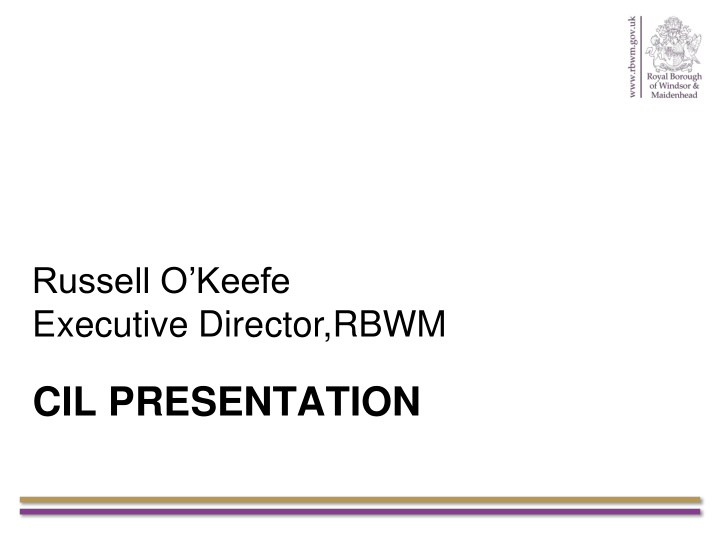



Russell O’Keefe Executive Director,RBWM CIL PRESENTATION
What can the Community Infrastructure Levy be spent on (and by whom)? • The levy can be used to fund a wide range of infrastructure, including transport, flood defences, schools, hospitals, and other health and social care facilities
What is the neighbourhood portion of the levy? • Fifteen per cent of Community Infrastructure Levy charging authority receipts are passed directly to those Parish and Town Councils where development has taken place. • Where chargeable development takes place within the local council area, up to £100 per existing council tax dwelling can be passed to the Parish, Town or Community Council this way each year to be spent on local priorities. • Areas could use some of the neighbourhood pot to develop a neighbourhood plan where it would support development by addressing the demands that development places on the area.
Parishes with a Neighbourhood Plan • In England, communities that draw up a neighbourhood plan or neighbourhood development order (including a community right to build order), and secure the consent of local people in a referendum, will benefit from 25 per cent of the levy revenues arising from the development that takes place in their area. • This amount will not be subject to an annual limit.
Spending the neighbourhood portion • Where a neighbourhood plan has been made, the charging authority and communities should consider how the neighbourhood portion can be used to deliver the infrastructure identified in the neighbourhood plan as required to address the demands of development. They should also have regard to the infrastructure needs of the wider area. • The charging authority and communities may also wish to consider appropriate linkages to the growth plans for the area and how neighbourhood levy spending might support these objectives.
Where there is no Parish, Town or Community Council, who receives the neighbourhood portion? • If there is no Parish, Town or Community Council, the charging authority will retain the levy receipts but should engage with the communities where development has taken place and agree with them how best to spend the neighbourhood funding.
When is the neighbourhood portion paid? • Regulation 59 specifies that the neighbourhood portion of levy receipts must be paid every six months, at the end of October and the end of April.
What happens where development straddles a Parish Council administrative boundary? • each council receives a share of the levy which is proportionate to the gross internal area of the development within their administrative area
CIL and Neighbourhood Planning • Legislation requires two payments per year
What can neighbourhood funding be spent on? • The neighbourhood portion of the levy can be spent on a wider range of things than the rest of the levy, provided that it meets the requirement to ‘support the development of the area • Parish, Town and Community Councils should work closely with their neighbouring councils and the charging authority to agree on infrastructure spending priorities • Parish, Town and Community Councils should consider publishing their priorities for spending the neighbourhood funding element, highlighting those that align with the charging authority. Where a neighbourhood plan has been made, it should be used to identify these priorities.
How should Parish Councils report on spending the levy? • There is no prescribed format. Parish, Town and Community Councils may choose to combine reporting on the levy with other reports they already produce. The levy neighbourhood funding income and spending will also be included in their overall published accounts but are not required to be identified separately in those accounts.
Recommend
More recommend